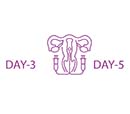SEQUENTIAL EMBRYO TRANSFER (SET)
The sequential transfer of Day 3 embryos followed by Day 5 embryos in the same cycle is referred to as Sequential embryo transfer.
According to various studies conducted, this method of transfer has been reported to increase the endometrial receptivity and thereby improving the chances of implantation (chances of embryos attaching the uterus lining) and finally having higher pregnancy outcome in patients with repeated IVF-ET failures.
Why go for Sequential embryo transfer?
- It is believed that first Day-3 transfer induces and increases the endometrial receptivity and release of certain chemicals (cytokines), thereby creating a better endometrial environment for Day-5 transfer.
- Since the timing of ‘implantation window’ may vary among patients depending on the endometrial response to the steroids, sequential transfer increases the chances of conception by increasing the probability of embryo getting attached to the endometrium well within time.
- Blastocyst transfer without exposing the cycle to the risk of cancellation.
Indications for Sequential embryo transfer?
- History of Recurrent Implantation Failure (RIF)
- Poor prognosis patient even in their first IVF-ET cycle in order to improve pregnancy outcome
- Before moving on to donor embryos, patients can also try this as a last resort
NOTE: Culturing embryos till the blastocyst stage(Day 5) can help avoid the random selection of defective ones and can also help reduce the risk of multiple pregnancy. However, there are cases when no blastocyst are formed, further increasing the risk of cycle cancellation. So, this method is suitable in such cases and for individuals with a high number of embryos.
Frequently asked questions
Q1. Who can opt for SET?
Ans :- Clinicians usually recommend this incase of patients who have had a history of failed implantation
Q2. Are there any side effects of SET?
Ans:- There is no such side effects of SET, though it might lead to multiple pregnancies, as more than one embryos are transferred. So, patients undergoing SET might have twins in one pregnancy

